Germany and Berlin become the frontline and pivotal stages for the geopolitical chess game known as the Cold War—a period of intense rivalry between the United States and the Soviet Union.
After the defeat of Nazi Germany in World War II, the country was partitioned into four zones of occupation by the victorious Allies. It wasn’t long before ideological disparities between the capitalist West and the communist East transformed these zones into front lines of a global struggle for influence.
Berlin, deep within the Soviet sector yet divided among all four powers, epitomized this confrontation, becoming a symbol of divided ideologies and a focal point for Cold War tensions.
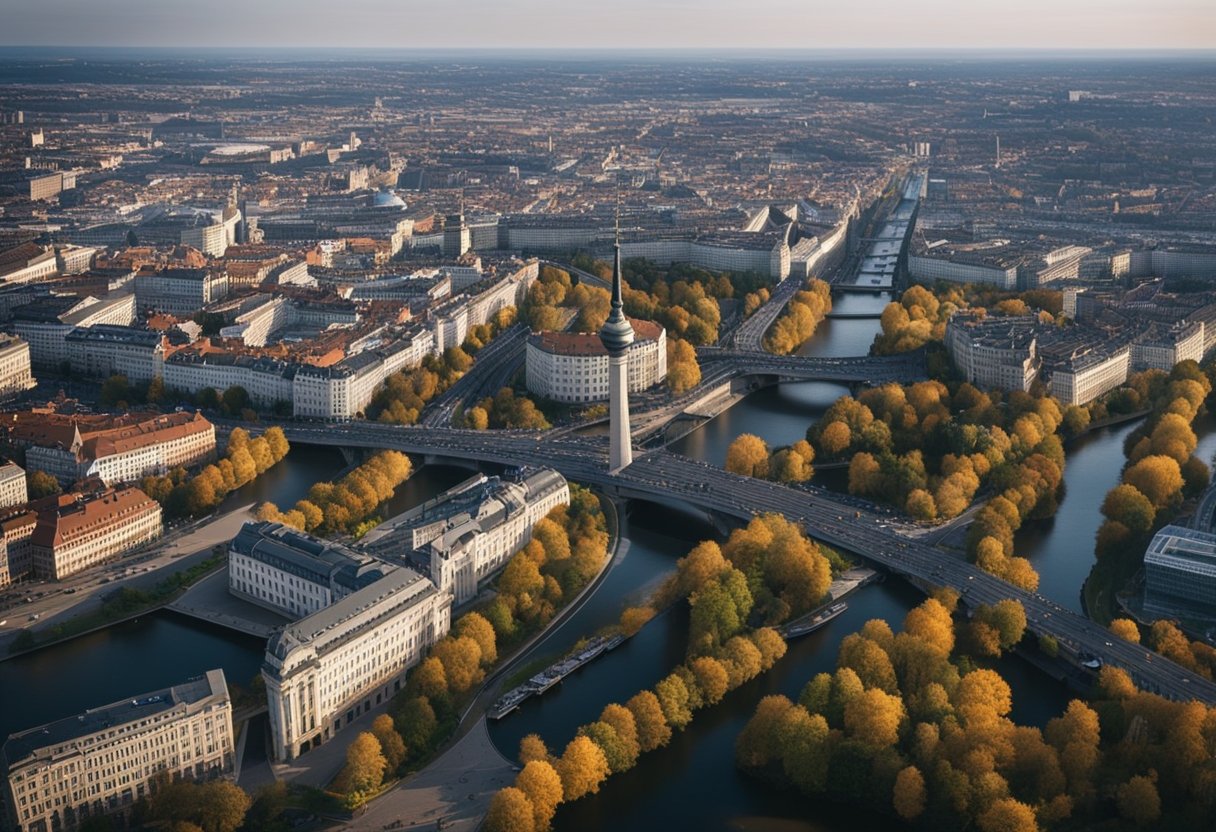
Tensions in Berlin escalated to the point where physical barriers, most notably the Berlin Wall, were erected, rendering the city a literal representation of the Iron Curtain separating East from West.
During this time, President John F. Kennedy delivered his famous speech in Berlin, underscoring the United States’ commitment to West Germany and the free world, famously stating, “Ich bin ein Berliner,” as a gesture of solidarity.
The city’s strategic significance, coupled with its status as a place where ideologies clashed openly, elevated Berlin to more than just a hotspot; it was the frontline of the Cold War.
It was here that the superpowers confronted each other, here that the West displayed its resolve against communist expansion, and here that ordinary citizens lived daily with the palpable tension of a divided world.
Historical Context of Germany and Berlin become the Frontline

The city of Berlin‘s pivotal role during the Cold War stemmed from the geopolitical and ideological divisions post-World War II, notably influenced by the outcomes of the Yalta Conference and the subsequent occupation zones.
Impact of World War II
World War II left Germany and its capital, Berlin, in ruins. The country’s defeat facilitated the Allies—the United States, UK, France, and the Soviet Union—to occupy and assume control. Berlin, situated deep within the Soviet-controlled territory, emerged as a microcosm of global tensions between communism and capitalism.
Yalta Conference and Its Implications
The Yalta Conference of 1945 was crucial in determining post-war Europe’s fate. The leaders of the Allied Powers convened to discuss Europe’s reorganization, leading to Germany’s division into occupation zones, each controlled by an Allied power.
This arrangement was meant to be temporary, ensuring stabilization and demilitarization, but ultimately sowed the seeds for prolonged division.
Formation of Occupation Zones
After the conclusion of World War II, Germany was partitioned into the Four Zones of occupation. Berlin, although wholly within the Soviet Zone, was similarly split amongst the Four Powers. These divisions not only reflected the physical occupation but also the ideological rifts that were beginning to characterize the East and West.
Rise of East and West Germany
As the post-war period progressed, different political ideologies took root: the Western Allies fostered democracy and capitalism in the Federal Republic of Germany (FRG or West Germany), while the Soviet Union established a socialist state in the German Democratic Republic (GDR or East Germany). Berlin became a frontline where these conflicting ideologies directly abutted and the Cold War tensions palpably played out.
Political Dynamics of the Cold War Era
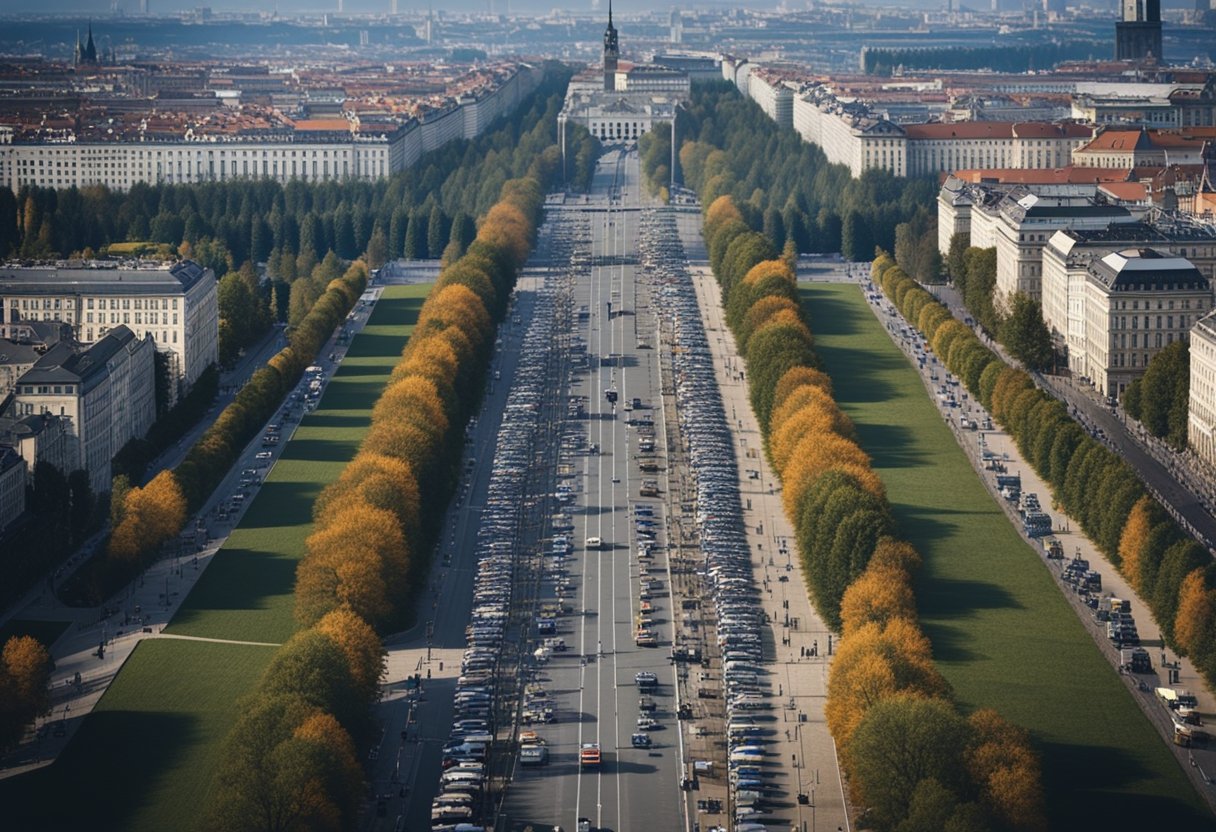
The Cold War era was marked by intense geopolitical contention between the Western bloc, led by the United States, and the Eastern bloc, headed by the Soviet Union. Berlin, located deep within the Soviet-controlled East Germany, emerged as the frontline of this global ideological conflict.
Allied Control Council and Shared Governance
After World War II, the Allied Control Council was established as a military occupation governing body, comprising representatives from the United States, the United Kingdom, France, and the Soviet Union.
It aimed to administer post-war Germany collectively. However, differing visions of governance and the beginnings of the Cold War soon led to tensions that would cause the Council to become ineffective.
Berlin Airlift and the Blockade
In 1948, the Soviets initiated a Blockade of West Berlin, aiming to pressure the Western Allies out of the city. In response, the Allies organized the Berlin Airlift, a massive humanitarian effort that supplied West Berliners with essential goods and symbolized resistance against Communist expansion.
Construction of the Berlin Wall
The construction of the Berlin Wall in 1961 was a dramatic escalation of the Cold War, physically dividing the city and embodying the ideological rift between East and West. It stood as a potent symbol of the division within Germany and was a pivotal point of tension in the Cold War.
Checkpoint Charlie and Refugee Crises
Checkpoint Charlie became the most famous crossing point between East and West Berlin. It was a symbol of the Cold War and a flashpoint for various refugee crises. Here, numerous individuals attempted to escape the repression of Communist East Germany, seeking the freedoms offered by the West.
Division of Berlin and Its Global Significance
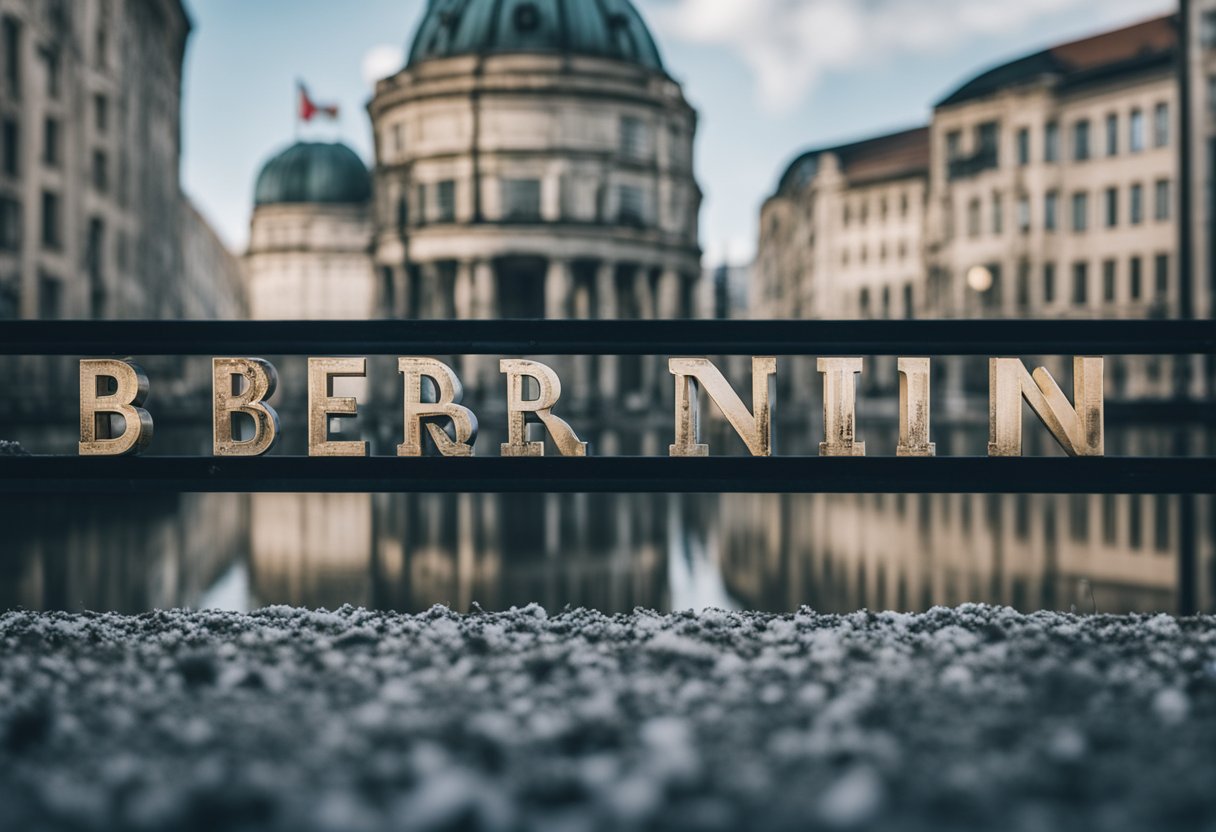
The division of Berlin into East and West became a tangible representation of the Cold War’s ideological divide, establishing the city as the frontline of global political tensions.
Physical and Ideological Division
Berlin’s partition was more than just a physical barrier; it manifested the burgeoning ideological discord between the Soviet Union and the democratic West. The Berlin Wall, erected in 1961, came to symbolize this division. It not only segregated the city but epitomized two opposing political and economic systems: Communism on one side and Democratic Ideals on the other.
West Berlin as a Symbol of Western Ideals
West Berlin emerged as an enclave of liberty amidst a Communist Government-controlled East Germany. Recognized internationally as part of the Federal Republic of Germany, this section of the capital city served as a bastion of democratic values and the market economy within Soviet-influenced territory.
The famous speech by President John F. Kennedy in 1963 reinforced West Berlin’s status when he declared solidarity with its citizens, affirming “Ich bin ein Berliner.”
East Berlin Under Communist Control
Conversely, East Berlin was the administrative heartland of East Germany and served as a high-profile showcase for the Soviet Union-backed socialist system.
Under strict communist governance, East Berlin was initially formed by the postwar division of the city, becoming the capital for the German Democratic Republic and was often depicted as a center of Soviet influence in Europe.
Life in a Divided City
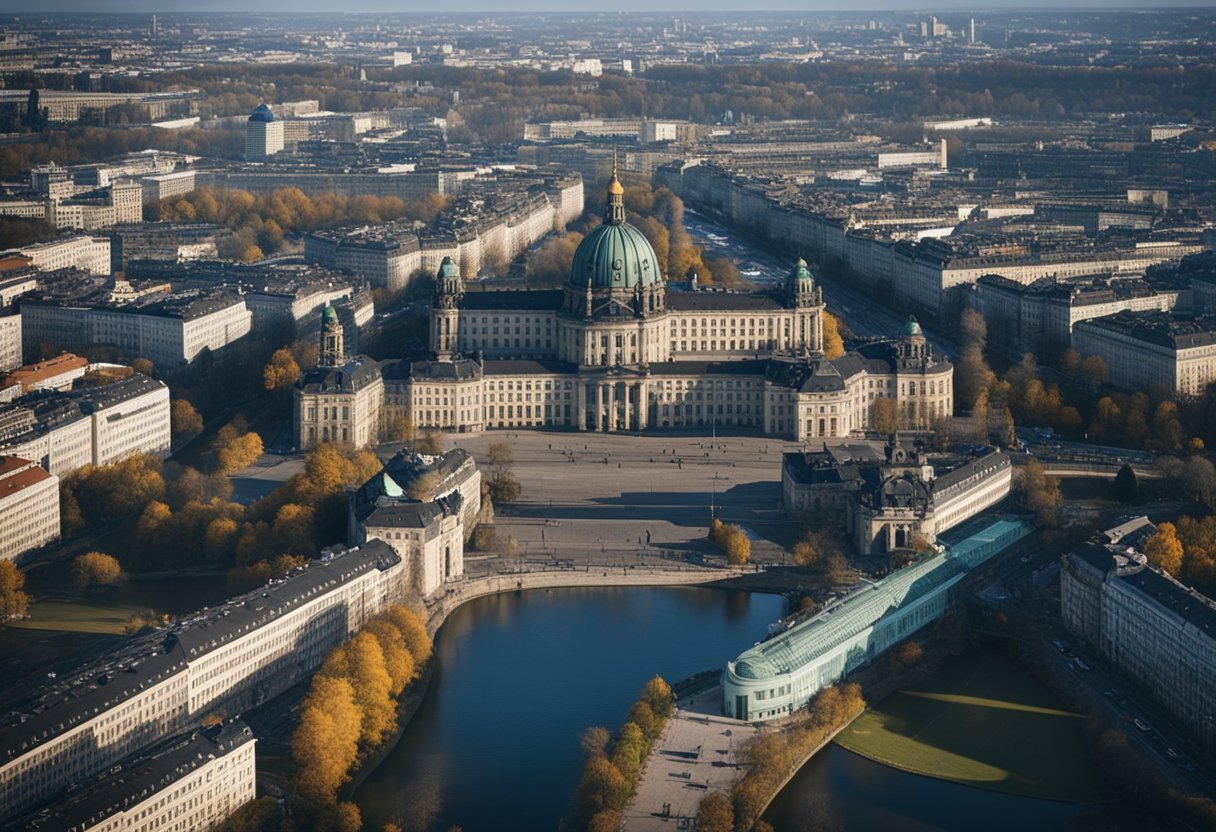
Berlin, during the Cold War, epitomized the tangible manifestation of a world divided by ideological conflicts. The city, split into East and West, was a daily reminder of the stark lifestyle contrasts and geopolitical tensions that defined the era.
Daily Realities Behind the Iron Curtain
Living in East Berlin, under the shadow of the Iron Curtain, meant adhering to a socialist system with inherent restrictions and constant surveillance. The East German border guards were a ubiquitous presence, tasked with preventing escape attempts to the West.
Life in East Berlin was marked by limitations in political freedom, economic opportunities, and personal liberties. The presence of barbed wire fences and guard towers throughout the city served as a grim reminder of the regime’s control.
Contrasts Between East and West Lifestyles
The contrast between the two Berlins could not have been more pronounced. West Berlin was a vibrant city with access to goods and a lifestyle reflective of Western capitalism. This stark difference was evident at border crossings, where glimpses into a more prosperous West Berlin could be seen.
The disparity in quality of life, freedom of expression, and access to information fueled a longing in many East Berliners for the opportunities available just beyond the barbed wire.
Escape Attempts and Border Security
The division of Berlin was a catalyst for numerous daring escape attempts by refugees seeking freedom in the West. The death strip, a no-man’s-land between East and West Berlin, was heavily fortified with armed guards, watchtowers, and barbed wire fences.
These formidable barriers did not deter all; however, as over the years, there were both successful escapes and tragic failures, often ending in loss of life at the hands of the border security forces.
Economic Disparities and Support Systems
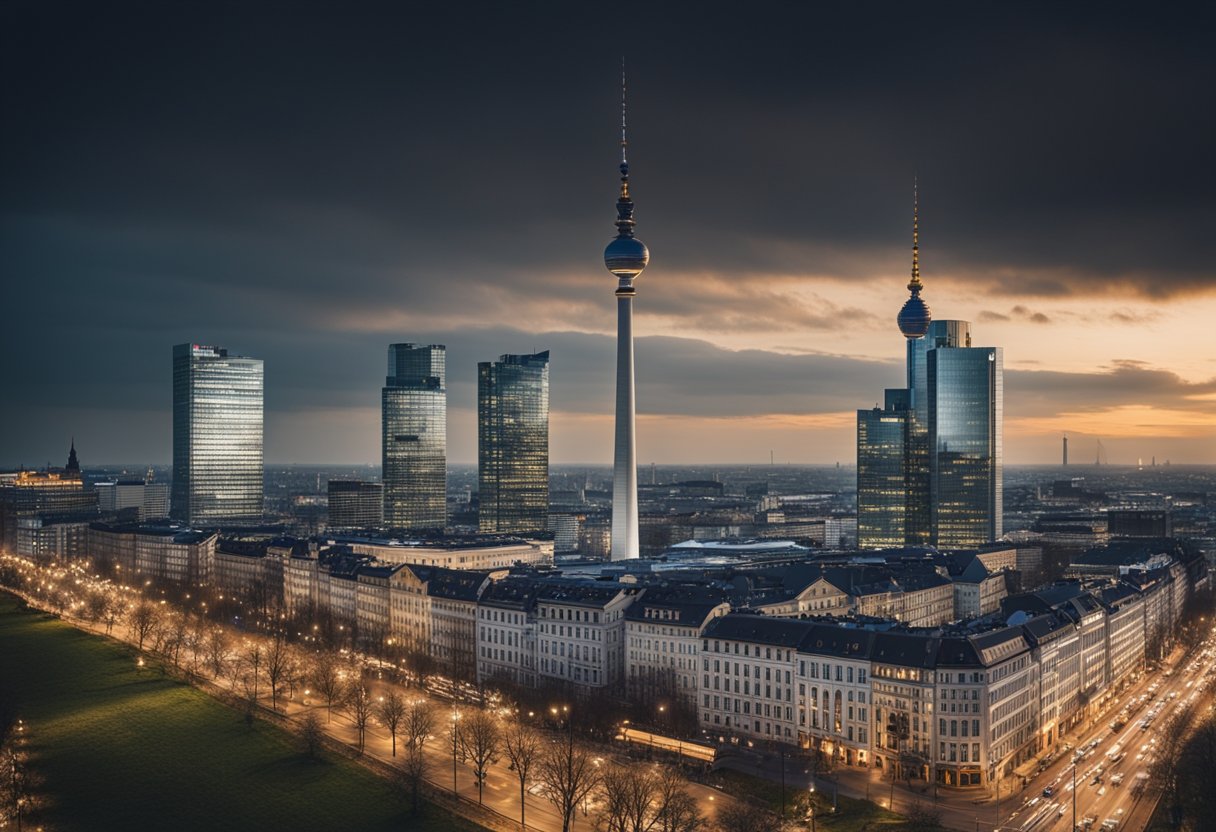
Following World War II, Germany’s economy faced significant division and rebuilding challenges. The implementation of support systems and economic strategies were markedly different in East and West Germany, leading to disparities that would influence the nation’s economy for decades.
Marshall Plan and Western Investment
The Marshall Plan, officially the European Recovery Program, was a vital element in West Germany’s post-war recovery. It provided over $12 billion in economic aid, helping to finance the country’s rebuilding efforts.
This influx of support catalyzed industrial growth and helped establish a stable foundation for the West German economy. The introduction of the Deutsche Mark under the Marshall Plan also stabilized the currency, instilling confidence and encouraging trade.
Soviet Reparations from East Germany
In stark contrast to the West, the East German economy was burdened by heavy reparations imposed by the Soviet Union.
These reparations took various forms, including the dismantling of factories and the appropriation of resources, which were then transferred to the Soviet Union. This resulted in a significant hindrance to economic growth and development in East Germany.
Currency Introduction and Trade Balance
The introduction of the Deutsche Mark in West Germany and the ostmark in East Germany created a clear economic rift. The West’s Deutsche Mark quickly gained international credibility and helped establish a positive trade balance.
Conversely, the ostmark struggled to gain acceptance outside the Eastern Bloc, limiting East Germany’s trade potential and integration into the global economy.
The stark split of Berlin and Germany’s role as the frontline of the Cold War can be traced back to these economic strategies and disparities, setting the stage for contrasting social and economic systems.
International Relations and Military Alliances
The division of Germany after World War II set the stage for the nation, particularly Berlin, to become a focal point for international relations and military alliances during the Cold War era.
The establishment of opposing military alliances and the strategic importance of Berlin in diplomatic negotiations underscored the city’s potential as a flashpoint for a Third World War.
Creation of NATO and the Warsaw Pact
The North Atlantic Treaty Organization (NATO) was formed in 1949, with nations of the Western Bloc seeking to counterbalance the expansion of Soviet influence in Europe.
In response, the Soviet Union and its satellite states established the Warsaw Pact in 1955, solidifying the division of Europe into two competing military alliances. This militarized standoff, particularly in divided Germany, made the country a symbol of the East-West tension.
Role of Berlin in Diplomacy and Espionage
Berlin emerged as a hub for diplomacy and espionage activities between the two superpowers. The presence of American, British, French, and Soviet forces in the city made it a hotbed for intelligence operations.
During the Berlin Crisis of 1961, President John F. Kennedy delivered the famous “Ich bin ein Berliner” speech, symbolizing the United States’ commitment to West Germany and emphasizing the strategic role of Berlin in upholding democratic values against communist ideologies.
Potential Flashpoint for Third World War
Tensions in Berlin indicated the potential for the city to become a flashpoint for a Third World War. The erection of the Berlin Wall in 1961 was a physical manifestation of the ideological clash that could potentially escalate into worldwide conflict.
The balance of power achieved through the existence of NATO and the Warsaw Pact was a crucial factor in maintaining peace and preventing military engagement between the nuclear-armed blocs.
The Path to German Reunification
German reunification marked a pivotal moment in history, characterized by Mikhail Gorbachev’s reformative policies, the historic fall of the Berlin Wall, and the gradual process of bringing together a divided nation into a united Germany.
Mikhail Gorbachev’s Policies and East German Reform
Under the leadership of Mikhail Gorbachev, the Soviet Union introduced significant political and economic reforms known as Glasnost (openness) and Perestroika (restructuring).
These policies influenced the East German government to initiate changes, paving the way for reform within the German Democratic Republic (GDR). Gorbachev’s approach allowed greater political discourse and challenges to the existing socialist system, fostering an environment where reunification could be considered.
Fall of the Berlin Wall and Open Borders
The fall of the Berlin Wall on November 9, 1989, stands as a momentous event signifying the end of the Cold War division in Germany.
With the opening of the borders, East Germans flocked to the West, leading to the physical and ideological collapse of the barrier that had separated families and friends for nearly three decades. The removal of the Wall represented the hope for a future where Germany would be whole once again.
From Division to a United Germany
Moving from a state of division to a unified Germany required the resolution of numerous political, economic, and social challenges. The Federal Republic of Germany (FRG) and GDR had to address a wide range of issues from merging economies to revising legal frameworks.
Ultimately, they signed a unification treaty, leading to the official reconstitution of Germany as a single nation on October 3, 1990. This act of unification not only reshaped the national identity of Germany but also redefined the geopolitical landscape of Europe.
Frequently Asked Questions
The pivotal role of Berlin during the Cold War, marked by key historical events, had profound implications for global politics and the day-to-day lives of those on either side of the Berlin Wall.
What historical events led to Berlin becoming a pivotal location during the Cold War?
Berlin became a focal point due to its occupation by the Allies after World War II and subsequent division into sectors, which reflected the growing ideological divide between the East and the West. The city’s location deep within Soviet-controlled East Germany made it a symbol of Cold War tensions. To explore more about the city’s strategic importance, consider reading insights on Why Berlin Mattered.
How did the fall of the Berlin Wall influence global politics?
The fall of the Berlin Wall in 1989 was a significant turning point, symbolizing the decline of Soviet influence and the rise of democratic movements across Eastern Europe, which subsequently led to the dissolution of the Soviet Union.
What was the significance of Berlin’s division in post-World War II recovery?
Berlin’s division served as a microcosm of the wider Cold War, with the city split into democratic West and communist East. The Berlin Wall became a physical and ideological barrier that represented the wider partition of Europe during the era.
What were the key factors contributing to the end of the Berlin Wall?
Public unrest and the erosion of communist power paved the way for the end of the Berlin Wall. Persistent protests and the weakening of Soviet control over Eastern Bloc countries contributed to the eventual dismantling of the wall.
How did the presence of the Berlin Wall affect daily life in East and West Germany?
The Berlin Wall drastically affected daily life by separating families, restricting movement, and symbolizing the stark contrast between the different political and economic systems of East and West Germany.
What role did Berlin play in the strategic interests of the United States during the Cold War?
Berlin was a strategic outpost for the United States to project its power and commitment to democracy in the face of Soviet communism. President John F. Kennedy underscored this in 1963 with his famed speech expressing solidarity with the citizens of West Berlin. This moment is a key example of the strategic significance of Berlin to the United States during this period.